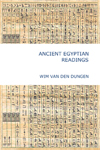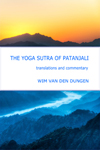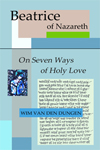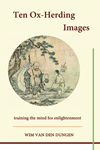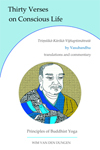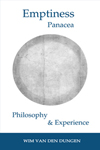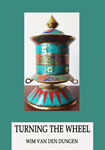| |

Studies
in
Buddhadharma
Preface
"We thus see that all the wranglings about the
nature of a thinking being, and its association with the material world,
arises simply from our filling the gap, due to our ignorance, with
paralogisms of reason, and by changing thoughts into things and
hypostatizing them." - Kant :
Critique of Pure Reason, A394.
 Contents
Contents  SiteMap
SiteMap

|
|
"I give You good counsel ; may You all take heed : cut
craving at its source !" -
Dhammapada, verse 337. |
|
|
Buddha
Śâkyamuni is clear : to truly end suffering, ignorance
has to stop ! There is no other way. This deluded "thirst"
("triśnâ") for sensual pleasure, existence, eternity &
self-annihilation brings the arising ("samudâya") of suffering. At
the heart of this "fire"
lies the false conviction, false ideation or
delusion phenomena have own-form ("svabhâva"), are
self-powered, possess eternal, substantial thingness. Thus reifying
thinking, the mind is spell-bound by its own power of definition,
fabrication & planning ("mâyâ). This hypnotic power is applied to
oneself, producing an inherently existing (ontic) self ("âtman") and applied
to all other phenomena, generating a supreme creator, a "being of
beings" deemed self-subsisting, self-powered & self-settled from his
own side ("Brahman"). Thus a more-or-less functional but mistaken
world of suffering results ("samsâra").
Ending this ignorance ("avidyâ") is to cut off the deluded
thirst where it begins, namely at its root.
Reifying objects of craving is the first cause of affliction. Misrepresenting
dynamic phenomena as static makes the hub of the wheel of
suffering or "samsâra"
spin.
Rational study & reflection reveal no static objects
can be found ! All objects function as other-powered phenomena, but
appear to the conventional, conceptual mind as cut off, separate, independent &
lasting. Meditation
is the key to realize
the wisdom-mind of Clear Light rooting out this misknowledge, misconception or
mistake.
Although the conceptual mind may accept the Three Marks of Existence
: impermanence, suffering & non-self, acting, feeling & thinking
as if objects are self-powered remains ongoing. Targeting own-form, emptiness
yoga aims to remove this fundamental delusion and bring about
true peace. |
Let us take heed of the teachings of the
Hînayâna or "Small Vehicle",
be inspired by the compassion of the
Mahâyâna or "Great Vehicle", and integrate desire into the path,
as in the Vajrayâna, or "Diamond Vehicle".
Once desire is taken into the path,
Tantra cannot be avoided.
The connections between, on the one hand, Western critical thought
and
process metaphysics
and, on the other hand, the philosophy of the Buddha are given by the latter's unique approach
of the word "śûnyatâ", the cornerstone and outstanding feature of this
philosophy, particularly as expounded by Nâgârjuna and his followers :
Chandrakîrti, Śântideva, Atiśa and
Tsongkhapa.
Placed in a soteriological context, the "Middle Way" develops the Kantian
distinction between "noumenon" (ultimate truth) and "phenomenon" (relative
truth) long before Kant (1724 - 1804), and so we may well ask whether the
Buddha was not the first critical philosopher ?
"The
Light of the Wish-Fulfilling Jewel will shine in the West."
Nechung Oracle to the XIVth Dalai Lama
in
1956.
When the Muslims invaded North India, Buddhist universities (like Nâlandâ)
were savagely destroyed. Multiple sources were lost. Fortunately, much earlier,
translations had been made & treasure-texts had been buried in Tibet, and
so after Buddhism went extinct in India, Tibetan Buddhism became the sole
keeper of the Lesser Vehicle, Greater Vehicle & "Secret Mantra", another
name for Buddhist Tantra. After 1959, when the XIVth Dalai Lama fled from
the Chinese communists, the
"Wish-Fulfulling Jewel" (another one of his many names) came to the West, and
the
new era of Western Buddhism got initiated. Buddhist Tantra became fashionable.
Although the influence of Tibetan monasticism as a whole was crucial to
keep & transmit the Buddhadharma in general and its Tantric teachings & practices
in particular, I have no intention to interlace or spice these studies with
Tibetan cultural traditions.
In the West, we are fortunate to have a wide variety of English sources
& Dharma centers available, making it possible to understand, reflect & meditate without
having to learn Tibetan and
incorporate the culture. Indeed, bringing the Buddhadharma into the path of the Western mind, calls for
the bracketing of more
than one Tibetan cultural element. Especially in Tantra, incorporating
Taoist Internal Alchemy may prove very useful.
Stressing the importance of individual practice, my presentation is in
harmony with our contemporary Western emphasis on personal intention,
motivation, education, action & responsibility. It takes a cheerful distance from
outdated forms of collective devotion, but this without altogether
eliminating the practice of Guru Yoga.
Enlightenment, the end of ignorance, reveals the true nature of phenomena. Reason-wise,
this true nature is the universal absence of inherent existence.
Experience-wise, it is the experience of the mind of Clear Light, of
bodhi-mind. The hub of
the cycle of "samsâra"
is a mind attributing self-power to phenomena.
Wisdom, the opposite
of ignorance, accepts conventional reality for what it is, namely a
totality of
functional, compounded, composed, contaminated entities, but negates the
mind designating these realities as "cut off", independent, sovereign & substantial. It
is thus necessary to realize a clear & distinct conceptual
understanding
of emptiness. Such a rational realization of the ultimate nature
of phenomena is however impossible without a supple, acute & tranquil mind
acting as its preliminary. Thus all begins with "mere sitting" ("za zen").
Understanding
the actuality of process over substance, of
other-power over self-power, of dynamism over stasis, etc.
allows for a more reasonable understanding of change or
process.
Although the view & the path depend on conditions, the fruit, enlightenment,
once realized, does
not. Beyond arising and cessation, its experience is utterly ineffable and object of
un-saying & un-knowing. Not "invented", "assembled" or
"created" by the Buddha, this Dharma was discovered to benefit
all sentient beings.
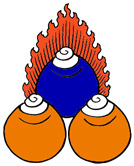
|
|




